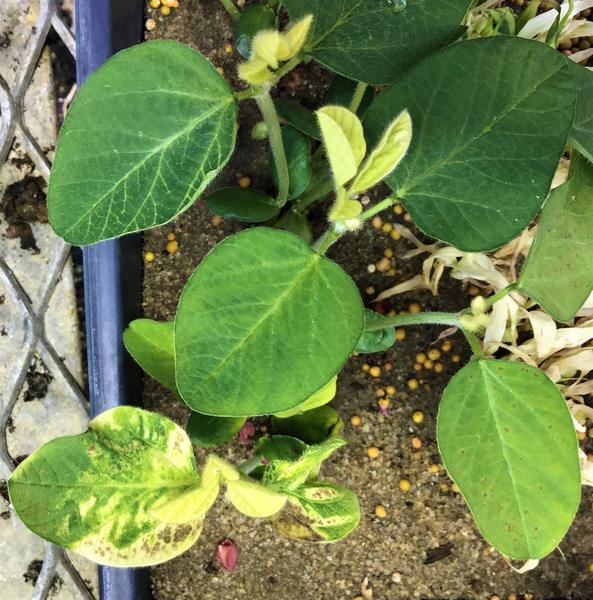Symptoms
4-hydroxyphenylpyruvate dioxygenase (HPPD)-inhibiting (herbicide group [HG] 27) herbicides are commonly referred to as the ‘bleacher’ herbicides. The HPPD-inhibiting herbicides inhibit plant pigment synthesis, which results in chlorosis and/or bleaching of vegetative tissue (Figure 1). Symptomology exhibited by treated plants may range from bleaching of the leaf margins to the entirety of the leaf. The HPPD-inhibiting herbicides are phloem mobile, resulting in injury being seen on new growth.
Injury incurred by the HPPD-inhibiting herbicides on soybeans can be transient if the doses are low or can result in plant death if the doses are high. Injury to soybeans can occur from physical drift or carryover from previous growing seasons. When a soybean plant emerges with bleached or chlorotic cotyledons and true leaves, the injury is likely from HPPD-inhibiting herbicide carryover. When injury to a soybean plant is when trifoliates are bleached and the injury severity decreases across the field, the injury is likely from HPPD-inhibiting herbicide drift. Injury caused by HPPD-inhibiting herbicides can be confused with injury caused by clomazone (HG 13). Clomazone is also referred to as a ‘bleacher’ herbicide that is applied pre-emergence. Injury caused by HPPD-inhibiting herbicides and clomazone are almost indistinguishable (Figures 1 and 3). However, injury caused to soybeans by clomazone will subside with time.
Management
Carry over injury from the HPPD-inhibiting herbicides can be avoided by following the labeled application and plant back restrictions. Physical drift can be avoided by spraying when the average wind speed is less than 10 miles an hour and mid-day or –afternoon to avoid a temperature inversion.
Publication date: Dec. 3, 2020
N.C. Cooperative Extension prohibits discrimination and harassment regardless of age, color, disability, family and marital status, gender identity, national origin, political beliefs, race, religion, sex (including pregnancy), sexual orientation and veteran status.
NC Cooperative Extension prohíbe la discriminación por raza, color, nacionalidad, edad, sexo (incluyendo el embarazo), discapacidad, religión, orientación sexual, identidad de género, información genética, afiliación política, y estatus de veteran.
The use of brand names in this publication does not imply endorsement by NC State University or N.C. A&T State University of the products or services named nor discrimination against similar products or services not mentioned.
Recommendations for the use of agricultural chemicals are included in this publication as a convenience to the reader. The use of brand names and any mention or listing of commercial products or services in this publication does not imply endorsement by NC State University or N.C. A&T State University nor discrimination against similar products or services not mentioned. Individuals who use agricultural chemicals are responsible for ensuring that the intended use complies with current regulations and conforms to the product label. Be sure to obtain current information about usage regulations and examine a current product label before applying any chemical. For assistance, contact your local N.C. Cooperative Extension county center.
N.C. Cooperative Extension prohibits discrimination and harassment regardless of age, color, disability, family and marital status, gender identity, national origin, political beliefs, race, religion, sex (including pregnancy), sexual orientation and veteran status.



